German army celebrates 60 years of service
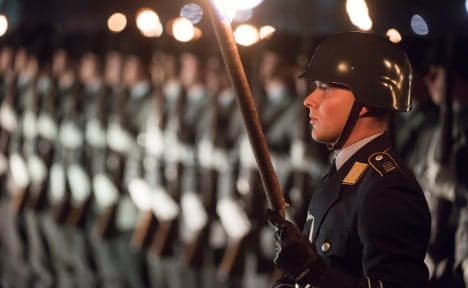
The German army has had a checkered history, to say the least – so much so that in 1955, it didn't actually exist at all. But 60 years ago on November 12th, the German Bundeswehr was born as a new kind of army for a new kind of state.
On Wednesday evening, the German Reichstag played host to an important anniversary.
1955 wurden die ersten Soldaten ernannt: Die Bundeswehr wird 60. Eindrücke vom heutigen Großen Zapfenstreich: https://t.co/c9ojY6Hi2W
— Steffen Seibert (@RegSprecher) November 11, 2015
Soldiers performed the "Großer Zapfenstreich" in front of the German parliament building - a "Grand Tattoo" considered the country's most important ceremonial act, and generally only performed during national celebrations or solemn public commemorations.
The occasion this week? November 12th marks 60 years since the formation of the Bundeswehr – Germany's modern armed forces.
Moving on from Hitler's army
Of course, it wasn't as if Germany had never had an army before 1955.
The problem was that the country's last official army – the Wehrmacht – had been headed up by Adolf Hitler.
But even before the Nazi period and the Wehrmacht's intimate involvement in crimes against humanity, the German army had a troubled past.
After Germany's defeat in the First World War, Allied forces had agreed that while the newly formed Weimar Republic did need an army, it must be strictly limited in size.
According to the Treaty of Versailles, the new Reichswehr could only have a standing army of 100,000 men, and a navy of 15,000.
No submarines were allowed, and aircraft of any kind were off the cards.
But after Hitler became Chancellor in 1933 he soon set in motion his grand plans for Germany's army.
He quickly established the Wehrmacht - with the goal of regaining lost German territory and dominating nearby countries.
Its soldiers swore personal loyalty to the Führer and embarked on the war of conquest and extermination that would bring about the destruction of the Third Reich.
By September 1945, the Wehrmacht was all but dissolved – a status made official on August 20th 1946.
Germany would have no army for the next nine years – and when it re-emerged in 1955, it was almost unrecognisable.
Paving the way for the Bundeswehr
Plans for a new German army began after West Germany joined Nato in May 1955, according to the official Bundeswehr website.
On June 7th, the Federal Ministry of Defence was formed - something which had been in the pipeline since October 1950.
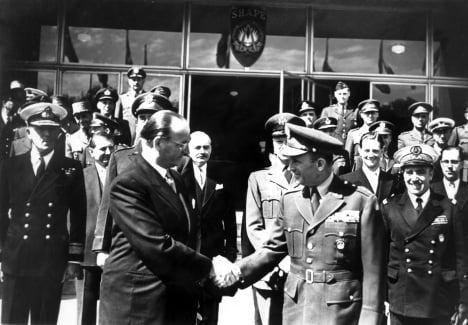
Paris, 1955: NATO commander-in-chief General Alfred Gruenther shakes hands with German representative General Hans Speidel after Germany's admission into Nato. Photo: DPA
During the summer of 1955, the West German government laid the legal framework for the new German army - and by August, around 150,000 former soldiers had made applications to the newly formed Ministry.
On October 4th, new Defence Minister Theodor Blank signed the first deployment order.
After the official opening ceremony on November 12th, volunteers would be conscripted into the Bundeswehr on a weekly basis - each Saturday, in fact.
No name, music or uniforms
But when the Bundeswehr was finally born, it was a fairly humble affair.
On November 12th 1955, six sergeants and 95 officers stood in the Ermekeil barracks in Bonn and received their certificates of appointment from the new Defence Minister.
With that, they became the first soldiers of the German Federal Republic.
But while many of the volunteers wore the new uniform, others were dressed in civilian clothes.
They didn't even have a name yet.
It wasn't exactly what German Chancellor Konrad Adenaur had expected.
Disappointed by the uniform shortage, it was also perhaps discouraging that the German national anthem wasn't played during the ceremony - as no band was available.
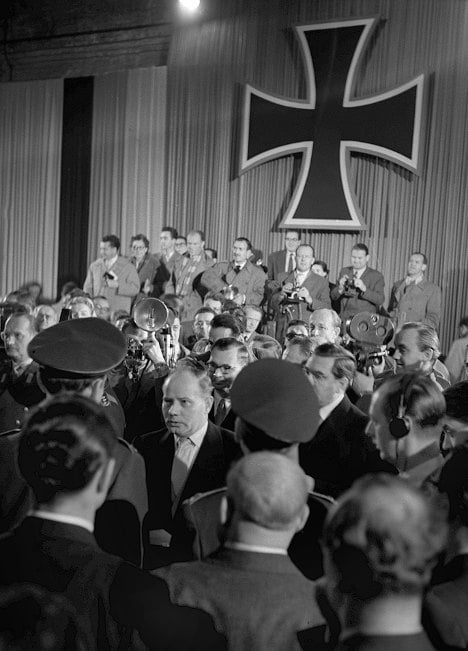
November 12th, 1955: The day 101 men became the first soldiers of the Bundeswehr. Photo: DPA
One carefully arranged detail, though, was the date.
November 12th 1955 marked the 200th birthday of Prussian military reformer General Gerhard von Scharnhorst.
Scharnhorst led German troops through the Napoleonic wars between 1801 and 1815 – and his legacy had influenced Germany's military for years and decades afterwards.
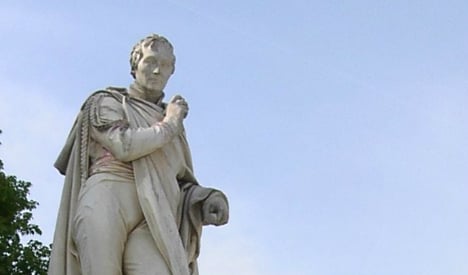
A statue of Gerhard von Scharnhorst on Unter den Linden in Berlin. Photo: Adam Carr/Wikimedia Commons
He had been the namesake for First World War armoured cruiser SMS Scharnhorst, as well as Second World War battleship Scharnhorst.
60 years of the Bundeswehr
The first Bundeswehr soldiers were mainly former Federal Border guards. In 1956, around 10,000 of the Border Guard's 17,000 members transferred to this new German army.
But a problem arose when Adenauer visited the new soldiers in Andernach in January 1956.
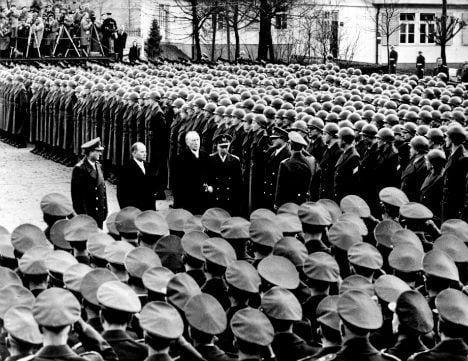
Chancellor Konrad Adenauer inspecting the Bundeswehr in January 1956. Photo: DPA
As the Chancellor opened his speech with "Soldiers of the new armed forces..." it became painfully obvious that the new West German troops needed an official name.
The term "Bundeswehr" was adopted by German parliament on March 20th 1956 - just a few weeks before the first conscription laws were introduced.
Since then, millions of men and thousands of women have passed through the forces.
German men and women stood ready throughout the Cold War to fight alongside Nato allies in the event of an attack against the West by the Soviet-led Warsaw Pact.
Today, the German Bundeswehr employs 169,172 professional and fixed-term soldiers, as well as 9,657 volunteer recruits (as recorded on the Bundeswehr website on 11 November 2015).
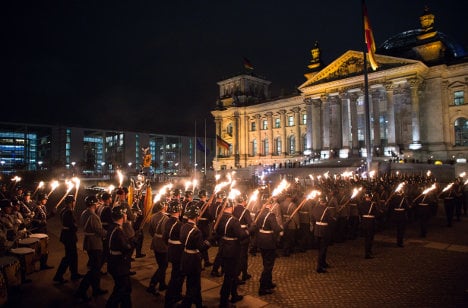
The Grand Tattoo illuminated the Reichstag on the evening of November 11th 2015. Photo: DPA
A far cry from the 101 men who stood in the barracks on November 12th 1955.
German soldiers abroad
By the turn of the Millennium, the Bundeswehr was increasingly active in war and crisis zones across the world - but always as part of international coalitions or United Nations missions.
Their first UN mission joined by German soldiers saw them travel to Cambodia to serve as peacekeepers in 1992.
By the mid-90s, German troops were deeply involved in IFOR, the Nato- and UN-sponsored mission to bring an end to conflict in the Balkans.
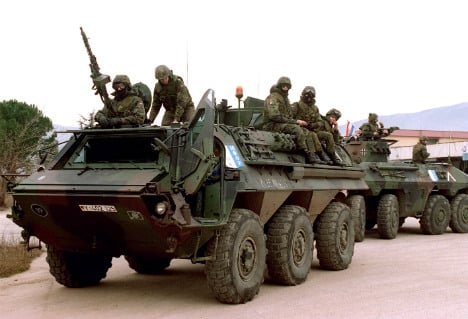
Bundeswehr soldiers ride on troop carriers in Mostar, Bosnia, in 1996. Photo: DPA
With around 660 soldiers still based in Kosovo as part of Nato's KFOR mission, the Balkans deployment has been the longest in the 60-year history of the Bundeswehr.
The Balkans also saw the Germans' first offensive military action against another country since the end of the Second World War.
Aircraft from the modern Luftwaffe (German air force) bombed Serbian anti-aircraft and radar installations starting in March 1999.
Chancellor Gerhard Schröder's Social Democratic Party and their Green coalition allies met massive resistance from their supporters, who saw Germany's joining the US- and British-led coalition against Serbia without UN approval as a breach of international law.
Just two years later, Germany joined the US-led intervention in Afghanistan to oust the Taliban after the September 11th attacks.
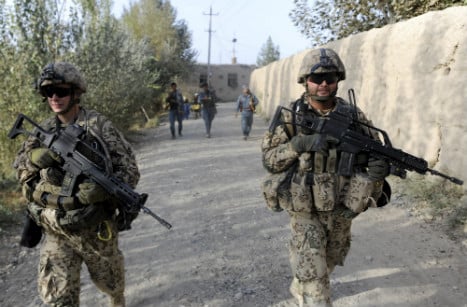
Bundeswehr soldiers on patrol in the Afghan district of Char Darreh in 2011. Photo: DPA
German soldiers are still there too, as part of NATO's "Resolute Support" mission - even as Afghan asylum seekers reach German territory from the country German troops have fought to secure for more than 13 years.
And German troops are busy in Iraq training the Kurdish Peshmerga fighters, who man the front lines against terrorist group Isis, to use tens of millions of euros worth of weapons provided by Germany.
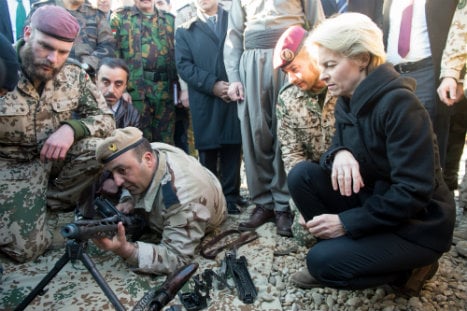
Defence Minister Ursula von der Leyen watches German and Kurdish troops training with the MG3 machine gun in Iraq. Photo: DPA
Challenges ahead
The Bundeswehr looks very different in 2015 than it did in 1956.
Its ranks are no longer swelled with regular infusions of young conscripts, as compulsory military service - which had already been softened with a civilian service option - was completely abolished in 2011.
Germany's fighting force faces tough questions over the state of its equipment, over the usefulness of its contributions to international aid missions, and even on whether the rifles it issues its soldiers can shoot straight when they're needed most.
Nevertheless, German servicemen and women are deployed far and wide across Europe, the Middle East, Africa and Central Asia.
Current deployments of the Bundeswehr worldwide. Click to enlarge. Image: Bundeswehr
Germany is less and less restrained by guilt about its past from sending its soldiers abroad when they're needed - although it remains one of the countries that feels itself most strictly bound by international law.
And despite continuing opposition from some in Germany to the very idea of the nation's having an armed force at all, the Bundeswehr's occasional wit in the face of protests suggests military leaders have a healthy streak of self-confidence about their role.
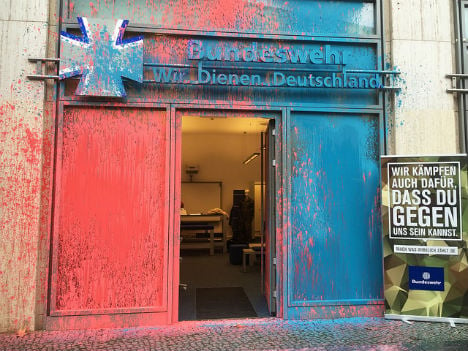
A Bundeswehr recruiting station in Berlin, seen after a paint attack by pacifist activists. Photo: DPA
When protesters threw paint over the entrance of a recruiting station in central Berlin this week in opposition to the Bundeswehr's 60th anniversary celebrations, the soldiers unfurled a banner that read "We also fight for your right to be against us" - and carried on as normal.
By Hannah Butler
Comments
See Also
On Wednesday evening, the German Reichstag played host to an important anniversary.
1955 wurden die ersten Soldaten ernannt: Die Bundeswehr wird 60. Eindrücke vom heutigen Großen Zapfenstreich: https://t.co/c9ojY6Hi2W
— Steffen Seibert (@RegSprecher) November 11, 2015
Soldiers performed the "Großer Zapfenstreich" in front of the German parliament building - a "Grand Tattoo" considered the country's most important ceremonial act, and generally only performed during national celebrations or solemn public commemorations.
The occasion this week? November 12th marks 60 years since the formation of the Bundeswehr – Germany's modern armed forces.
Moving on from Hitler's army
Of course, it wasn't as if Germany had never had an army before 1955.
The problem was that the country's last official army – the Wehrmacht – had been headed up by Adolf Hitler.
But even before the Nazi period and the Wehrmacht's intimate involvement in crimes against humanity, the German army had a troubled past.
After Germany's defeat in the First World War, Allied forces had agreed that while the newly formed Weimar Republic did need an army, it must be strictly limited in size.
According to the Treaty of Versailles, the new Reichswehr could only have a standing army of 100,000 men, and a navy of 15,000.
No submarines were allowed, and aircraft of any kind were off the cards.
But after Hitler became Chancellor in 1933 he soon set in motion his grand plans for Germany's army.
He quickly established the Wehrmacht - with the goal of regaining lost German territory and dominating nearby countries.
Its soldiers swore personal loyalty to the Führer and embarked on the war of conquest and extermination that would bring about the destruction of the Third Reich.
By September 1945, the Wehrmacht was all but dissolved – a status made official on August 20th 1946.
Germany would have no army for the next nine years – and when it re-emerged in 1955, it was almost unrecognisable.
Paving the way for the Bundeswehr
Plans for a new German army began after West Germany joined Nato in May 1955, according to the official Bundeswehr website.
On June 7th, the Federal Ministry of Defence was formed - something which had been in the pipeline since October 1950.

Paris, 1955: NATO commander-in-chief General Alfred Gruenther shakes hands with German representative General Hans Speidel after Germany's admission into Nato. Photo: DPA
During the summer of 1955, the West German government laid the legal framework for the new German army - and by August, around 150,000 former soldiers had made applications to the newly formed Ministry.
On October 4th, new Defence Minister Theodor Blank signed the first deployment order.
After the official opening ceremony on November 12th, volunteers would be conscripted into the Bundeswehr on a weekly basis - each Saturday, in fact.
No name, music or uniforms
But when the Bundeswehr was finally born, it was a fairly humble affair.
On November 12th 1955, six sergeants and 95 officers stood in the Ermekeil barracks in Bonn and received their certificates of appointment from the new Defence Minister.
With that, they became the first soldiers of the German Federal Republic.
But while many of the volunteers wore the new uniform, others were dressed in civilian clothes.
They didn't even have a name yet.
It wasn't exactly what German Chancellor Konrad Adenaur had expected.
Disappointed by the uniform shortage, it was also perhaps discouraging that the German national anthem wasn't played during the ceremony - as no band was available.

November 12th, 1955: The day 101 men became the first soldiers of the Bundeswehr. Photo: DPA
One carefully arranged detail, though, was the date.
November 12th 1955 marked the 200th birthday of Prussian military reformer General Gerhard von Scharnhorst.
Scharnhorst led German troops through the Napoleonic wars between 1801 and 1815 – and his legacy had influenced Germany's military for years and decades afterwards.

A statue of Gerhard von Scharnhorst on Unter den Linden in Berlin. Photo: Adam Carr/Wikimedia Commons
He had been the namesake for First World War armoured cruiser SMS Scharnhorst, as well as Second World War battleship Scharnhorst.
60 years of the Bundeswehr
The first Bundeswehr soldiers were mainly former Federal Border guards. In 1956, around 10,000 of the Border Guard's 17,000 members transferred to this new German army.
But a problem arose when Adenauer visited the new soldiers in Andernach in January 1956.

Chancellor Konrad Adenauer inspecting the Bundeswehr in January 1956. Photo: DPA
As the Chancellor opened his speech with "Soldiers of the new armed forces..." it became painfully obvious that the new West German troops needed an official name.
The term "Bundeswehr" was adopted by German parliament on March 20th 1956 - just a few weeks before the first conscription laws were introduced.
Since then, millions of men and thousands of women have passed through the forces.
German men and women stood ready throughout the Cold War to fight alongside Nato allies in the event of an attack against the West by the Soviet-led Warsaw Pact.
Today, the German Bundeswehr employs 169,172 professional and fixed-term soldiers, as well as 9,657 volunteer recruits (as recorded on the Bundeswehr website on 11 November 2015).

The Grand Tattoo illuminated the Reichstag on the evening of November 11th 2015. Photo: DPA
A far cry from the 101 men who stood in the barracks on November 12th 1955.
German soldiers abroad
By the turn of the Millennium, the Bundeswehr was increasingly active in war and crisis zones across the world - but always as part of international coalitions or United Nations missions.
Their first UN mission joined by German soldiers saw them travel to Cambodia to serve as peacekeepers in 1992.
By the mid-90s, German troops were deeply involved in IFOR, the Nato- and UN-sponsored mission to bring an end to conflict in the Balkans.

Bundeswehr soldiers ride on troop carriers in Mostar, Bosnia, in 1996. Photo: DPA
With around 660 soldiers still based in Kosovo as part of Nato's KFOR mission, the Balkans deployment has been the longest in the 60-year history of the Bundeswehr.
The Balkans also saw the Germans' first offensive military action against another country since the end of the Second World War.
Aircraft from the modern Luftwaffe (German air force) bombed Serbian anti-aircraft and radar installations starting in March 1999.
Chancellor Gerhard Schröder's Social Democratic Party and their Green coalition allies met massive resistance from their supporters, who saw Germany's joining the US- and British-led coalition against Serbia without UN approval as a breach of international law.
Just two years later, Germany joined the US-led intervention in Afghanistan to oust the Taliban after the September 11th attacks.

Bundeswehr soldiers on patrol in the Afghan district of Char Darreh in 2011. Photo: DPA
German soldiers are still there too, as part of NATO's "Resolute Support" mission - even as Afghan asylum seekers reach German territory from the country German troops have fought to secure for more than 13 years.
And German troops are busy in Iraq training the Kurdish Peshmerga fighters, who man the front lines against terrorist group Isis, to use tens of millions of euros worth of weapons provided by Germany.

Defence Minister Ursula von der Leyen watches German and Kurdish troops training with the MG3 machine gun in Iraq. Photo: DPA
Challenges ahead
The Bundeswehr looks very different in 2015 than it did in 1956.
Its ranks are no longer swelled with regular infusions of young conscripts, as compulsory military service - which had already been softened with a civilian service option - was completely abolished in 2011.
Germany's fighting force faces tough questions over the state of its equipment, over the usefulness of its contributions to international aid missions, and even on whether the rifles it issues its soldiers can shoot straight when they're needed most.
Nevertheless, German servicemen and women are deployed far and wide across Europe, the Middle East, Africa and Central Asia.
Current deployments of the Bundeswehr worldwide. Click to enlarge. Image: Bundeswehr
Germany is less and less restrained by guilt about its past from sending its soldiers abroad when they're needed - although it remains one of the countries that feels itself most strictly bound by international law.
And despite continuing opposition from some in Germany to the very idea of the nation's having an armed force at all, the Bundeswehr's occasional wit in the face of protests suggests military leaders have a healthy streak of self-confidence about their role.

A Bundeswehr recruiting station in Berlin, seen after a paint attack by pacifist activists. Photo: DPA
When protesters threw paint over the entrance of a recruiting station in central Berlin this week in opposition to the Bundeswehr's 60th anniversary celebrations, the soldiers unfurled a banner that read "We also fight for your right to be against us" - and carried on as normal.
By Hannah Butler
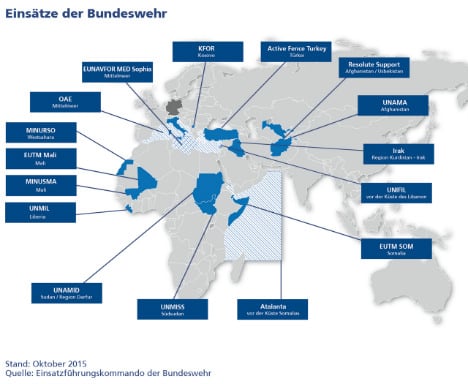
Join the conversation in our comments section below. Share your own views and experience and if you have a question or suggestion for our journalists then email us at [email protected].
Please keep comments civil, constructive and on topic – and make sure to read our terms of use before getting involved.
Please log in here to leave a comment.